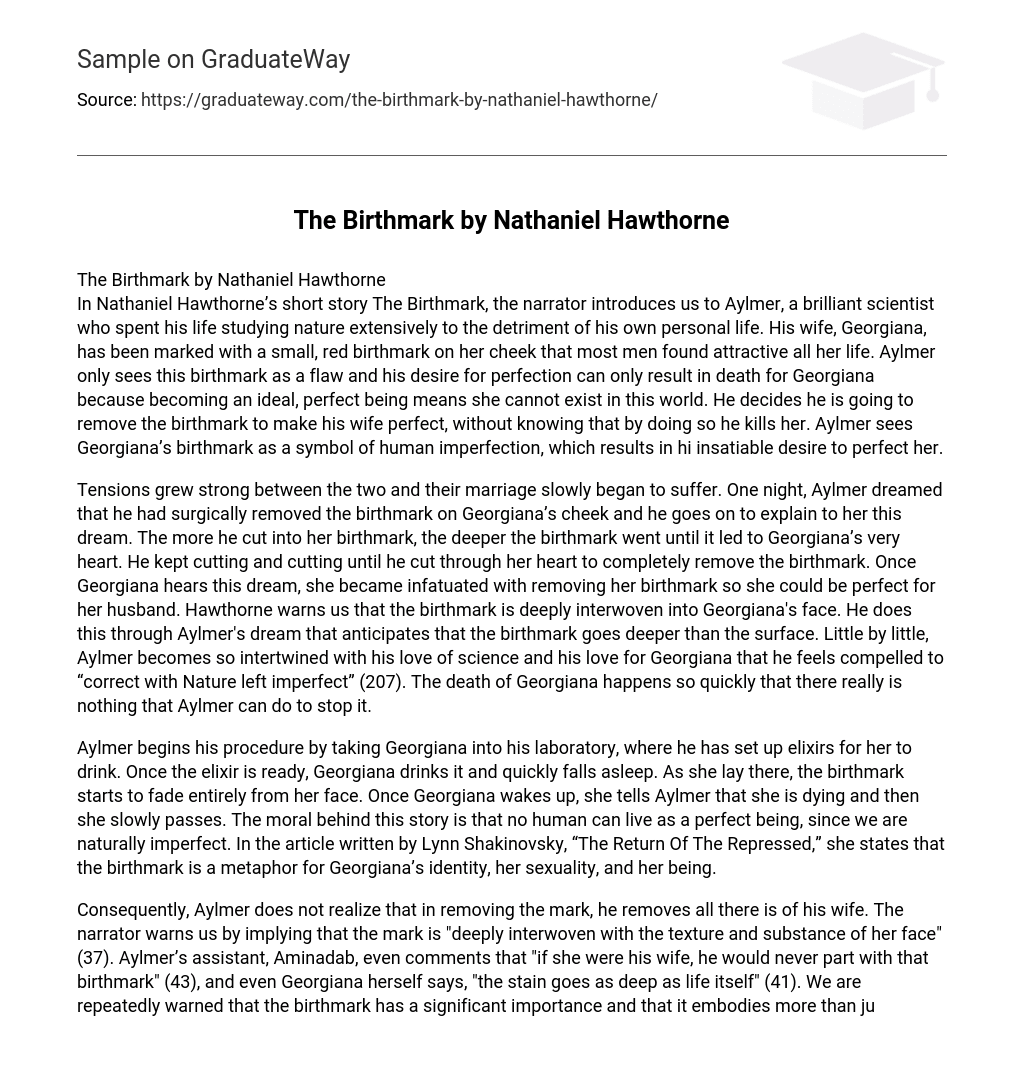The narrator presents Nathaniel Hawthorne’s short story The Birthmark, introducing Aylmer, a brilliant scientist who dedicated his life to the extensive study of nature, neglecting his personal life. Throughout her life, Aylmer’s wife Georgiana possesses a small, attractive red birthmark on her cheek that drew admiration from most men. However, Aylmer views this birthmark as a flaw and is driven by an insatiable desire for perfection. However, he fails to understand that striving for perfection can lead to Georgiana’s demise since being an ideal being makes her incompatible with the real world. Unaware of the consequences, Aylmer decides to remove the birthmark in his pursuit of making his wife perfect, ultimately causing her death. For Aylmer, Georgiana’s birthmark symbolizes human imperfection, fueling his relentless pursuit of perfection.
The tensions between the couple grew stronger and their marriage began to suffer. One night, Aylmer has a dream where he surgically removes Georgiana’s birthmark on her cheek. He shares this dream with her, explaining how he cuts deeper and deeper into the birthmark until it reaches her heart. Georgiana becomes obsessed with removing the birthmark to please her husband after hearing about this dream. Hawthorne warns that the birthmark is deeply ingrained in Georgiana’s face, as shown in Aylmer’s dream where it extends beyond the surface. Aylmer’s love for science and his love for Georgiana become so intertwined that he feels compelled to try to “correct” what nature has deemed imperfect. Unfortunately, Georgiana’s death occurs quickly, leaving Aylmer unable to do anything to prevent it.
In his laboratory, Aylmer takes Georgiana, where he has prepared elixirs for her to consume. After drinking the elixir, Georgiana falls asleep, and during this time, the birthmark on her face completely fades away. Upon awakening, Georgiana informs Aylmer of her impending death and eventually passes away. The underlying message of this tale is that it is impossible for humans to attain perfection since we possess inherent imperfections. In Lynn Shakinovsky’s article, “The Return Of The Repressed,” she suggests that the birthmark symbolizes Georgiana’s identity, sexuality, and existence.
Consequently, Aylmer fails to recognize that by removing the mark, he is removing his wife entirely. The narrator cautions us by suggesting that the mark is deeply ingrained in her face. Aylmer’s assistant, Aminadab, goes as far as to say that if he were married to her, he would never get rid of the birthmark. Similarly, Georgiana herself acknowledges that the stain is as deeply rooted as life itself. We are repeatedly reminded that the birthmark holds immense significance and represents more than just a physical flaw.
The motif is also present in Aylmer’s dream: “the deeper went the knife, the deeper sank the hand, until at length its tiny grasp appeared to have caught hold of Georgiana’s heart.” (40). Shakinovsky also explores the reasons behind Aylmer’s interference with science and nature. She explains that for Aylmer, the mark represents Georgiana’s connection to earthly things, her imperfection in the heavenly realm, and therefore, it is unacceptable. The narrator shares a similar perspective with Aylmer, viewing the mark as a flaw that implies her true perfection. However, he fails to grasp the mark’s symbolic quality and its potential for multiple meanings. (7). The character of Georgiana is further examined in an article by Barbara Eckstein titled “Hawthorne’s The Birthmark: Science and Romance as Belief.”
The author notes that prior to marrying Aylmer, Georgiana had suitors, a protective mother, and competitive women. According to the author, many of the men who courted Georgiana embraced her birthmark as a delightful aspect, like a mythical attribute. Surprisingly, Georgiana never considered her birthmark to be a flaw in her beauty and did not anticipate Aylmer wanting it removed. The author believes it is understandable that Georgiana felt hurt and angered by Aylmer’s proposal to eliminate her birthmark in order to achieve perfection. The author asserts that Georgiana’s lack of preparedness for such a request in their marriage is not surprising considering the absence of any indications during their courtship.
Throughout her life, Georgiana has been conditioned to believe that romance is the path to a happy marriage, but not to the extent of sacrificing herself. After witnessing Aylmer’s overwhelming obsession with eliminating her birthmark for countless seasons, Georgiana eventually chose to confront the subject herself. This decision eventually leads her to view her own existence as a burden and a sorrowful possession. According to Eckstein, Georgiana is both a victim and a participant in her own demise, ultimately becoming a martyr to the ideals of romance. By surgically removing Georgiana’s imperfection, Aylmer also strips away her humanity. As a result, Georgiana’s flawless and idealized self is rendered lifeless, as she ceases to exist as an individual.
The narrator suggests that every living thing has flaws, indicating that death is inevitable. Despite being a mere blemish, the birthmark on Georgiana’s cheek does not diminish her beauty; rather, it serves as a testament to her humanity. However, Aylmer cannot overlook his repulsion towards the birthmark, which ultimately leads him astray. Aylmer becomes fixated on perfecting his wife and misinterprets the meaning behind Georgiana’s birthmark. This pursuit of perfection proves futile since true perfection belongs solely to heaven and cannot be achieved on earth (Shakinovsky 9). Georgiana’s desire for flawlessness ultimately leads to her demise as she cannot exist in this world as an ideal, flawless being. Eventually, Aylmer’s insatiable hunger for manipulating nature through science only results in the loss of his wife and personal unhappiness.
Works Cited
- Eckstein, Barbara. “Hawthorne’s The Birthmark’: Science and Romance as Belief.” Studies in Short Fiction. 26: 1989, 511-19.
- Quinn, James and Ross Baldessarini. “‘The Birthmark’: A Deathmark.” University of Hartford Studies in Literature: A Journal of Interdisciplinary-Criticism. 1981, 13: 2, 91-98.
- Zanger, Jules. “Speaking of the Unspeakable: Hawthorne’s ‘The Birthmark.’ ” ModernPhilolosopy. May 1983, 80:4, 364-71.





